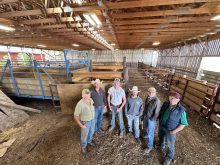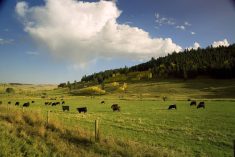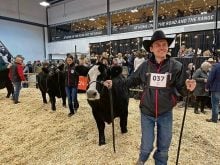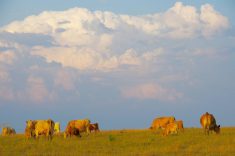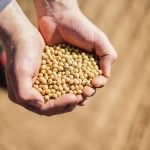What kid doesn’t know about tasty burgers, fries and pizza?
But how many know that it all starts on somebody’s farm? Too few, sadly.
Two years ago some folks in Yorkton, Sask., did something to bridge this gap by laying out their first pizza farm. It’s a fun place, where schoolchildren have a chance to learn about, and grow the ingredients in their favourite foods.
The idea started with the staff of the Saskatchewan Ministry of Agriculture (SMA) in Yorkton in partnership with Agriculture in the Classroom, Saskatchewan (AITC-SK). And it’s growing.
Read Also

Building demand together: The impact of Canada’s beef import levy
The beef import levy has become a central tool for ensuring balance in Canada’s beef industry
The Carrot River Valley Watershed Association (CRVWA) teamed up with Farm Link Marketing Solutions at Melfort in 2014 to put a new spin on this concept by organizing a burger and fries ranch.
SMA staff at Moose Jaw came on board that same year with another pizza farm.
This September put a wrap on pizza farms at Yorkton, Saskatoon, and Prince Albert along with the burger and fries ranches at Melfort, Moose Jaw and Outlook.
Food Farm has since become the umbrella term for SMA-affiliated farms, leaving the theme open to the imagination. Tacos anyone?
AITC-SK partners with local SMA ag-awareness champions and other host organizations to help with anything from organizing the schools to programming, helping the teachers and followup classroom presentations. As well, AITC-SK often looks after booking and manning Agrium’s popular Seed Survivor trailer. The interactive displays and games teach about soil, water, and how plants grow, the importance of plants to human survival, and how modern technology helps farmers care for crops to grow food for people around the world.
There’s no requirement to contact SMA or AITC-SK if a Food Farm sounds like something you’d like to bring to your community. All it really takes to get the ball rolling is a host organization that’s willing to take the lead.
“Food Farms are a perfect fit with Saskatchewan’s Grade 3 and Grade 4 science curriculum,” says AITC-SK programs manager Leah Hermanson. “Grade 3 focuses on plants and soils, and Grade 4 focuses on Saskatchewan agriculture.”

The details vary with the community but generally Grade 3 students plant the menu ingredients, then return in September as Grade 4 students to help with harvesting and preparing the meal. Other activities related to food production and the role of agriculture in the community keep students busy during spring and fall field days.
The host group organizes and manages the site from planting through harvest, sets the agenda, and finds the sponsors and volunteers needed to pull it all together. Food Farm sites have ranged from Monsanto research sites to demonstration farms, grain terminal yards and private land.
“The number of volunteers from producer groups, industry, the schools and the community is phenomenal,” Hermanson says.
Yorkton and Melfort organizers found seed and input suppliers, grain-marketing companies, greenhouses, local businesses, community groups and individuals eager to sponsor the Food Farm once they heard about the concept.
Saskatchewan Agriculture’s Ag Awareness Initiative also provides funding to projects such as locally organized Food Farms that bolster the public perception of agriculture.
Planting pizza at Yorkton
Tomatoes, onions, peppers, garlic and herbs form the sauce.
Wheat supplies the flour and canola the oil to form the crust. Some crop wedges are seeded with modern technology and inputs. Others are broadcast by hand. By fall the side-by-side comparison shows pretty clearly the advantage of modern methods.
Two wedges are reserved for a September field trip where they showcase a pig as the source of the ham and pepperoni and a dairy cow that supplies the cheese. Students then harvest the garden and haul the ingredients back to the school where they make their pizzas from scratch.
Many of the students had never been on a farm before, up to 90 per cent in one class, so this provided a unique experience for them.
Burgers and fries at Melfort
Even in this small city of 5,000 located in an area dominated by agriculture there were children who had never been to a farm and farm kids who may not have had an opportunity to see all sides of agriculture, says Carrot River Valley Watershed Association manager Lynne Rozell.
Members of the Beatty 4-H Beef Club set up the live animal display and explained about their animals, their club and the activities 4-H offers kids from all walks of life.
SMA livestock specialist Alicia Sopatyk, who covered the basics of beef production last year, says she got into some very enthusiastic discussions in the half-hour she had with each group. She told them about what cattle eat and how the rumen digests it as well as different types of beef operations and the purpose of the dangle tags and radio frequency identification tags in the ears. There were some unexpected questions, too, about hormones, slaughterhouses and butcher shops, meat packaging and labels, which showed their understanding that farm animals have to be harvested for food.
This year, 4-H club leader Dale Atkinson ended his discussions by weighing a steer and then having students gather on the scale to find out how many of them it took to match the steer.
Syngenta donated staff time and inputs to plant and harvest the plots of wheat, canola and mustard where students learned about the crop cycle, nutrients and weeds. In the fall they came back and found out how wheat is ground into flour for buns, canola is crushed to make cooking oil and mustard ends up in squeeze bottles on the grocer’s shelf.
Volunteers from SaskMilk were on hand to talk about what goes into making butter.
Cervus Farm Equipment placed a large air seeder at the site as a visual contrast to the equipment of days gone by on display at Farm Link’s Glenda Murphy’s acreage.
Gardening activities took on a unique twist the first year when torrents of rain left the plots too muddy to plant, so the organizers improvised by having students seed grocery ingredients in Ag-More-Than-Ever tote bags and volunteers planted the garden when weather permitted. As things turned out these mobile gardens were a hit with parents and the students who were able to watch their gardens grow during the summer break.
In fact, the garden-in-a-bag worked so well they did it again this year, even though the weather was better on planting day. Volunteers from Wright’s Greenhouse and Farm Credit Canada helped students plant their bags and their own potatoes in the main garden where they learned about companion planting and other gardening tips. Volunteers then planted the other fixings: tomatoes, onions, lettuce, peppers and carrots.
In September, the potato station sizzled with activity as students made homemade fries to compare with ready-made fries. Then they learned how the condiments are made, and prepared their own fixings. Prairie North Co-op donated the food for the spring and fall barbecue lunches.
For more information and tips on organizing a Food Farm, contact SMA’s Agriculture Knowledge Centre at 306-694-3727, AITC-SK at 306-933-5204, CRVWA at 306-752-1270 or follow along on Twitter at #burgerandfriesfarm.






